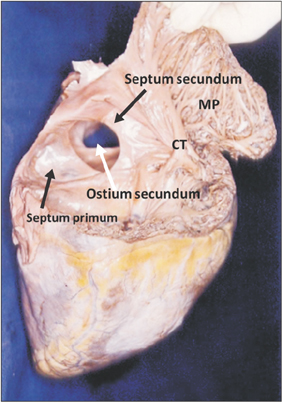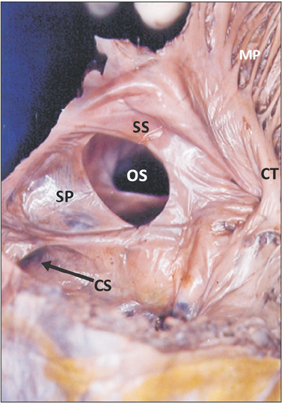Anat Cell Biol.
2017 Jun;50(2):152-154. 10.5115/acb.2017.50.2.152.
Functional and clinical importance of a large sized ostium secundum defect in a middle aged female cadaver: a case report
- Affiliations
-
- 1Department of Anatomy, Melaka Manipal Medical College (Manipal Campus), Manipal University, Manipal, India. nayaksathish@gmail.com
- KMID: 2451241
- DOI: http://doi.org/10.5115/acb.2017.50.2.152
Abstract
- Atrial septal defect (ASD) is one of the common congenital anomalies of the heart in humans. Its complications depend on the size of the defect and can manifest at any age. The common symptoms of ASD include dyspnea and fatigue. Most of the ASDs are associated with morbidity and mortality, Earlier the treatment, it is better to the patient. I saw a large ostium secundum defect in the heart of an adult female cadaver during dissection classes for undergraduate medical students. The interatrial septum had large defect at the region where fossa ovalis should have been located. It was about 1.25 inches in diameter and oval in shape. This type of large septal defect might result in cyanosis, stroke or death of the patient at any age.
MeSH Terms
Figure
Reference
-
1. Sadler TW. Langman's medical embryology. 11th ed. Philadelphia, PA: Lippincott Williams and Wilkins;2011. p. 175.2. Burn J, Brennan P, Little J, Holloway S, Coffey R, Somerville J, Dennis NR, Allan L, Arnold R, Deanfield JE, Godman M, Houston A, Keeton B, Oakley C, Scott O, Silove E, Wilkinson J, Pembrey M, Hunter AS. Recurrence risks in offspring of adults with major heart defects: results from first cohort of British collaborative study. Lancet. 1998; 351:311–316.3. Uebing A, Steer PJ, Yentis SM, Gatzoulis MA. Pregnancy and congenital heart disease. BMJ. 2006; 332:401–406.4. Campbell M. Natural history of atrial septal defect. Br Heart J. 1970; 32:820–826.5. Konstantinides S, Geibel A, Olschewski M, Görnandt L, Roskamm H, Spillner G, Just H, Kasper W. A comparison of surgical and medical therapy for atrial septal defect in adults. N Engl J Med. 1995; 333:469–473.6. Attie F, Rosas M, Granados N, Zabal C, Buendía A, Calderón J. Surgical treatment for secundum atrial septal defects in patients >40 years old. A randomized clinical trial. J Am Coll Cardiol. 2001; 38:2035–2042.7. Choong CK, Calvert PA, Falter F, Mathur R, Appleton D, Wells FC, Schofield PM, Crawford R. Life-threatening impending paradoxical embolus caught "red-handed": successful management by multidisciplinary team approach. J Thorac Cardiovasc Surg. 2008; 136:527–528.8. Kim RJ, Girardi LN. "Lots of clots": multiple thromboemboli including a huge paradoxical embolus in a 29-year old man. Int J Cardiol. 2008; 129:e50–e52.9. Ahmed S, Sadiq A, Siddiqui AK, Borgen E, Mattana J. Paradoxical arterial emboli causing acute limb ischemia in a patient with essential thrombocytosis. Am J Med Sci. 2003; 326:156–158.10. Cabanes L, Mas JL, Cohen A, Amarenco P, Cabanes PA, Oubary P, Chedru F, Guérin F, Bousser MG, de Recondo J. Atrial septal aneurysm and patent foramen ovale as risk factors for cryptogenic stroke in patients less than 55 years of age: a study using transesophageal echocardiography. Stroke. 1993; 24:1865–1873.11. Di Tullio M, Sacco RL, Gopal A, Mohr JP, Homma S. Patent foramen ovale as a risk factor for cryptogenic stroke. Ann Intern Med. 1992; 117:461–465.12. Handke M, Harloff A, Olschewski M, Hetzel A, Geibel A. Patent foramen ovale and cryptogenic stroke in older patients. N Engl J Med. 2007; 357:2262–2268.
- Full Text Links
- Actions
-
Cited
- CITED
-
- Close
- Share
- Similar articles
-
- Clinical Course of the Ostium Secundum Atrial Septal Defect(ASD) and Its Rate of Spontaneous Closure
- Visualization of Ostium Secundum Atrial Septal Defect by Transesophageal Echocardiography
- A Case of Ehlers-Danlos Syndrome Accompanied by Mitral Valvular Prolapse and Atrial Septal Defect
- Persistent Left Superior Vena Cava with Absent Right Superior Vena Cava and Large Atrial Septal Defect in Visceroatrial Situs solitus
- The Effects of Right Anterolateral Thoracotomy in Cardiac Surgery



